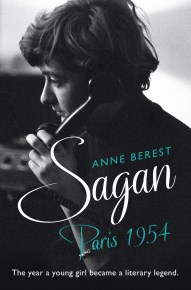‘Sagan, Paris 1954’: an ode to a French literary icon

To mark the 60th publication anniversary of ‘Bonjour Tristesse’, Sagan’s son, Denis Westhoff asked Parisian author and journalist Anne Berest to write a book about his mother.
‘Sagan, Paris 1954’ alternates between the life of Francoise in 1954, and the life of the narrator and author Anne Berest in the present day.
French connection: Sagan 1954 and Berest 2015
Writing this novel took Berest on a deeply personal journey, wherein she was changed by the memory of an ambitious young French girl.
On one hand we have a young Francoise Sagan, the adored daughter of a bourgeois family in Paris. Francoise drinks whisky with her father, drives a Ferrari and pens a bestselling novel from her childhood bedroom.
We witness she and her brother wrap the manuscripts of her novel up in brown paper, and follow her as she delivers them confidently to the major publishing houses of Paris. “She had never doubted a response would come soon, but she had been wondering how many more days she would have to wait.”
On the other hand we have Anne Berest, a recently divorced mother struggling to re-build her life. Her research into Sagan is life altering, as she develops a sense of closeness to the timeless 18-year-old.
She is inspired by Francoise to adopt a similar fearless approach to life. In a particularly eerie scene, she recounts communicating with Sagan through a clairvoyant, and describes the feeling that the famous writer was trying to live life for a final time through her. “She will teach you. Let her enjoy some final moment through you.”
A magnetic fille française
By speaking to old friends of Francoise, Berest does her best to capture who the 18-year-old Sagan was: a stubborn, generous girl with boyish hair and no regard for the rules imposed on the young ladies of her class. She slept late, flirted with men and always lived life on her own terms. Berest harnesses this energy and uses it as a foundation for her book, making it an uplifting and authentic read.
At age 12, Sagan was expelled from the Louise-de-Bettignies school and spent the three months left before the summer holidays wandering the streets of Paris without her parents’ knowledge. Of this, Berest writes: “it is more incredible than the millions of books sold, the fortunes spent, the carry-ons in casinos, the passionate love affairs: that small girl is my heroine.”
She continues: “How I love little girls – they delight me, they fascinate me, I envy them for still being like boys, without curves or bleeding, yet with all the strength that women have. I do believe that there is nothing more potent, more monstrously potent, than a little girl of twelve.”
‘Sagan, Paris 1954’ gives us a glimpse into just that — the bourgeois Parisian life of a character between girlhood and womanhood, merging fur coats and cocktails with the daily pleasures of an insouciant child.
She bit into her buttered bread with honey – to begin with, it pushed her mouth out of shape and gets wedged against her palate, then the honey mixes with the butter to form a nectar that trickles into the bread, softening it as far as the crust…
Berest skilfully captures the era between the pages of her book, and you only have to open it to find yourself standing on the Pont des Arts with Francoise, as she vows that she will find a publisher.
Forever young, forever French, forever Francoise

I love reading about writers and the outrageousness of Sagan’s situation – having written a bestseller in 1954 as a female at such a young age is inspirational and exciting.
Anne Berest does a brilliant job of conjuring up the image of a fierce girl-child with wisdom beyond her years, who radiates talent and a casual confidence that got her where she wanted to be.
The novel does not discuss much of Sagan’s later life, but rather leaves us with a Peter Pan-esque version of a girl who never really grew up. Its author chooses instead to focus on the tender beginnings of Francoise’s path to fame, the literary prizes and attention her novel was awarded long before society began to “destroy her.”
This glimpse into the life of Francoise Sagan is bold and beautifully written, enchanting us with the spirit of a woman who was well ahead of her time.
What do you think of Francoise Sagan? Share your thoughts with us in the comments below.
‘Sagan, Paris 1954’, published by Gallic Books and translated by Heather Lloyd, can be purchased on Amazon for the UK and Australia, or directly from Gallic Books. Image credits:
1. ‘Sagan, Paris 1954’, via Gallic Books.
2. ‘Bonjour Tristesse‘, by Nico Quatrevingtsix, via Flickr.
3. ‘View of Paris from the Arc de Triomphe, May 19, 1954’, by Kent Kanouse, via Flickr.







